NZXT Phantom 630 Case Review: The Relentless Pursuit of Perfection
by Dustin Sklavos on January 20, 2013 12:01 AM ESTNoise and Thermal Testing, Stock
It's a cold winter here in northern California, and the NZXT Phantom 630's efficient cooling design doesn't really help much. Keeping with current testing methodology, I tested the 630's fans at each of their three settings. I also removed any drive cages that weren't needed (as I have with other cases with removable cages), and I mounted the system SSD to the rear of the motherboard tray instead of using a standard drive sled. Any SSD in front of the intake fan is going to be particularly frosty; we need to see just how bad the thermals might get behind a loaded motherboard.
I'm keen to point out that this configuration isn't particularly far from what a modern high end system should be able to achieve. Most people will probably need around two drive trays, only slightly obscuring the front intake more than our single drive tray does.
Ambient temperature during testing hovered around 21C.
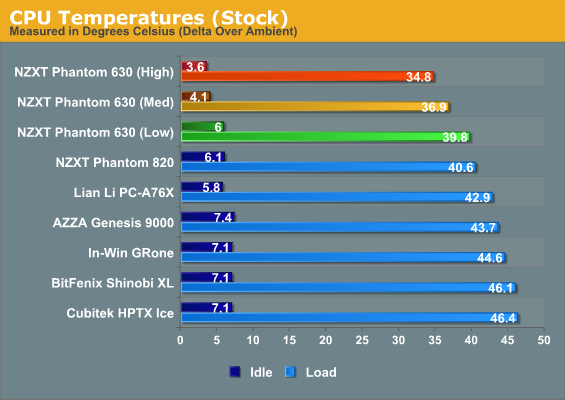
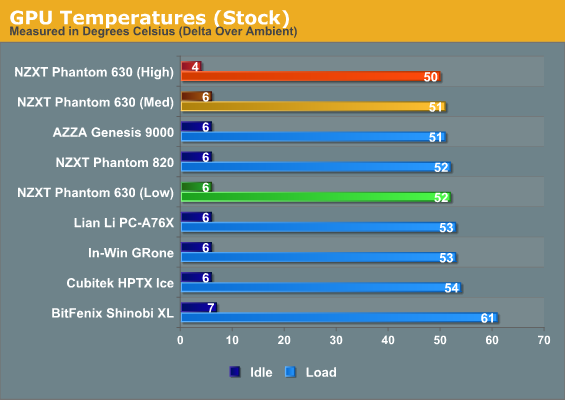
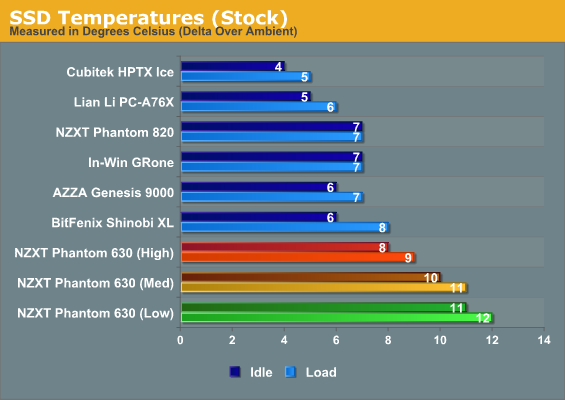
Stock testing starts off with a bang. Even at the lowest fan setting, the Phantom 630 runs the CPU cooler than the other cases tested, and even the GPU thermals are competitive. The SSD runs hotter than the other systems, but keep in mind we're still well south of 40C; the hottest I ever saw the SSD hit during any testing was 34C. Take note how the less expensive Phantom 630 at worst ties the 820; this is going to be a repeating pattern. The 820 is using its lowest fan setting, but the highest one only improves temperatures by about 4C; in other words, not enough to beat the 630.
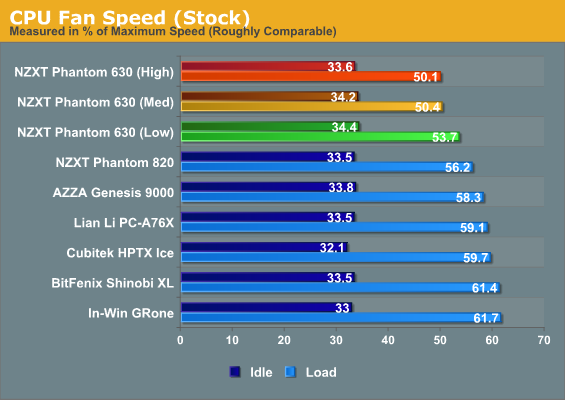
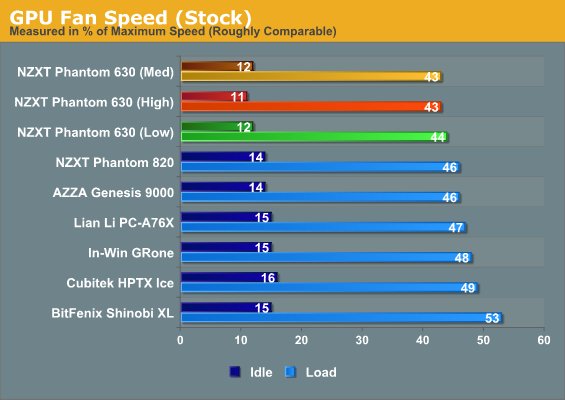
Fan speeds continue to show a healthy amount of headroom. The stock testbed doesn't stress the 630 at all.
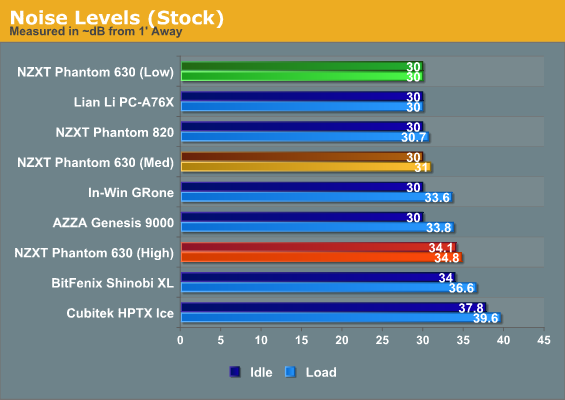
You can see the medium fan setting produces a nice balance between thermals and acoustics. Noise remains relatively low, while temperatures are at least competitive if not outright victories. At the high fan setting, performance is tremendous, but not really worth the noise.










44 Comments
View All Comments
3ogdy - Sunday, January 20, 2013 - link
Oh, look these cases look so much better than NZXT's Phantom:They're awesome
http://homepages.ihug.co.nz/~wayrich/computer-hist...
http://www.vmaxcanada.com/products/case/q500.jpg
http://museumvictoria.com.au/collections/itemimage...
http://www.stsnetwork.com/imagesnojava/pc_case.gif
http://assets.overclock.net.s3.amazonaws.com/3/3f/...
With these modern and stylish cases, I still don't understnad how NZXT can make such ugly cases
/irony
lockdown571 - Sunday, January 20, 2013 - link
Yeah I don't really get all the criticisms about styling. I find most cases are either too plane or horribly gaudy. I think this strikes a nice balance. I also HATE how most computer cases leave the optical drives exposed. That's actually one of the major reasons I bought the NZXT Phantom. To each their own though.Stan Zaske - Sunday, January 20, 2013 - link
Very nice styling. Excellent functionality. Too expensive. Nice article.HisDivineOrder - Sunday, January 20, 2013 - link
That, padding, and you've got a great silent case. I do like the hd cage design where you decide if you want a lot of hd's or just the 1 SSD+ 1 HD config a lot of gamers will go for.Tech-Curious - Sunday, January 20, 2013 - link
Excellent review, as usual.Have you reviewed any interesting cases with a top-mounted PSU lately, Dustin? Any of those cases in the pipeline? Just curious.
pdjblum - Sunday, January 20, 2013 - link
Do not get why you continue to refuse to list the materials in the specifications.londiste - Monday, January 21, 2013 - link
only the single-bay drive cage was installed for the tests? how much would more drive cages affect the cooling performance?are the drive cages interchangeable, i.e. can you only use the 2-bay cage at the bottom of the case?
beepboy - Monday, January 21, 2013 - link
I wouldn't shell this much for a case that's not made out of all aluminum. 27 lbs for an empty case is a little too heavy for my taste.HardwareDufus - Monday, January 21, 2013 - link
It's the least offensive of the current crop of robot/transformer like cases. Great function...not so hott form...but then again..I recognize there is an audience for a case with these looks.Magichands8 - Thursday, January 24, 2013 - link
I know I'm a little late commenting on this so I probably wont' get any kind of response but I'm a little confused about the results for this case. I'm comparing this one with the Nanoxia DS 1. Looking at the results for the noise and thermals (CPU, overclocked) it appears that the Phantom 630 is doing a better job at cooling than the Nanoxia DS1 at the same noise levels. Then, in the review for the 630, Dustin says:"If noise is your utmost concern you're never going to really beat the Nanoxia Deep Silence 1..."
How can this be the case (ahem!) if the results show the same noise readings at the same distance?
Also, he states:
"The windowed side panel looks better than its predecessor and obviously contributes to the case's killer performance..."
How could a windowed side panel contribute to the cases performance? I would think that a solid steel side panel would be better at reducing noise and even slightly better for heat dissipation.